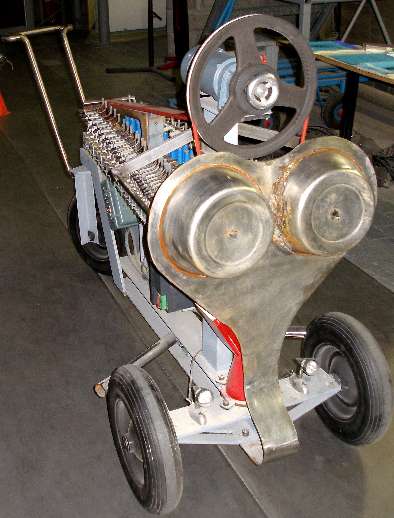

Religionszwang
Godfried-Willem Raes
2007
This piece was composed as a demonstration for the possibilities of my
<Hurdy> robot , built
in 2004 using its electromagnetic string driver mechanism, added in 2007.
The tuning of the steel strings must be 33 (low A) and 50 (D). It is essential
for this piece to have the strings tuned with a precision not less than
1 cent.
The piece demonstrates the nonexistence of just harmonics in physical, real world, strings. In most music theory books you will find stated that the overtone series of a string corresponds to a series f(n) = n . fo, whereby n runs in integers from 1 to above audibility for f(n). This theory belongs to religion rather than science, as is demonstrated clearly in this composition, where we force the strings to resonate on mathematically (or religiously...) correct overtones whereby we clearly hear that very often resonance is way off from what such theory predicts. The truth is that no 3-dimensional physical object in nature can vibrate in a mode conforming to integer-number spectral tones. Only 1-dimensional electronic oscillators (in hardware or in software) may do so. The electromagnetic driver we designed for the <Hurdy> robot has an extremely good precision and thus makes it possible to falsify the just harmonics theory, by comparing string behavior as a response to this form of excitation. In this piece we used the phenomenon of the variable response of the string to the excitation as a compositional principle, determining the dynamics of the piece in a most natural way. At the start of the piece the two strings sound D, an octave apart, using the tangent finger mechanism on the robot. The drive mechanisms of both strings wander through the overtone series, whereby the duration's are calculated in terms of the dissonance/consonance properties of the diads sounding. After a while, the bow wheel starts slowly turning and the bow mechanism comes into action, causing some contrasting crude and harsh sounds. A simple transposition/modulation follows and the piece ends on both strings sounding A, but now with a spread of two octaves. The composition is entirely embedded in software written within the framework of my <GMT> programming language.
In a second piece -actually identically the same code is used to generate it- we use physical reality to determine what the overtone series should be. As a starting point we used the following approximate formula for the calculation of the spectral components and overtones is a real string:
f(n) = n. f(o) SQR(1+ (B.(n^2)))
wherein n= 1,2,3,4...., f(n) the frequency of the partial, f(o) the frequency of the fundamental tuning of the string, and
B = (¶.e.µ.(d^2)) / (16.p.K.(L^2))
wherein: e = Young's modulus, µ = mass of the string in kg/m, d=circumference of the string, p= density of the string material in kg/m3, K= force on the string in Newton, L= length of the string in m.
The results where used in the frequency generator for the electromagnetic driver and then corrected for optimal response from the string.
The resulting music is an awful lot more resonant but
also, shows many more interesting beats and interference's in the diads.
The rythmical structure is a bit different from the first version due
to its dependency of diad dissonance.
This version is called 'Scientia vincere tenebras'..., reflecting physical
reality rather than religious illusion. It should be clear that 'Scientia
vincere tenebras' cannot be a 'finished' and closed piece. As knowledge
advances and models for strings change, the math behind the piece should
be updated in accordance with the latest findings.
'Religionszwang' was premiered in a first try out on 22nd of November 2007 by the author and his <Hurdy> robot. 'Scientia Vincere Tenebras' on march 5th 2008. Both pieces will appear on the LPD CD 'Lonely Robots' in 2010.
Religionszwang MP3: . [MP3 download]
Scientia Vincere Tenebras: [MP3 download]

| Terug naar M&M orkest | Terug naar Logos Website |
P.S.: Voor uitvoeringen van dit stuk moeten noch mogen auteursrechten worden betaald. Elke poging tot inning van auteursrechten naar aanleiding van publieke uitvoeringen van dit stuk, inklusief opnames ervan, kan gerechterlijk als poging tot afpersing worden vervolgd.
Last update: September 4, 2011